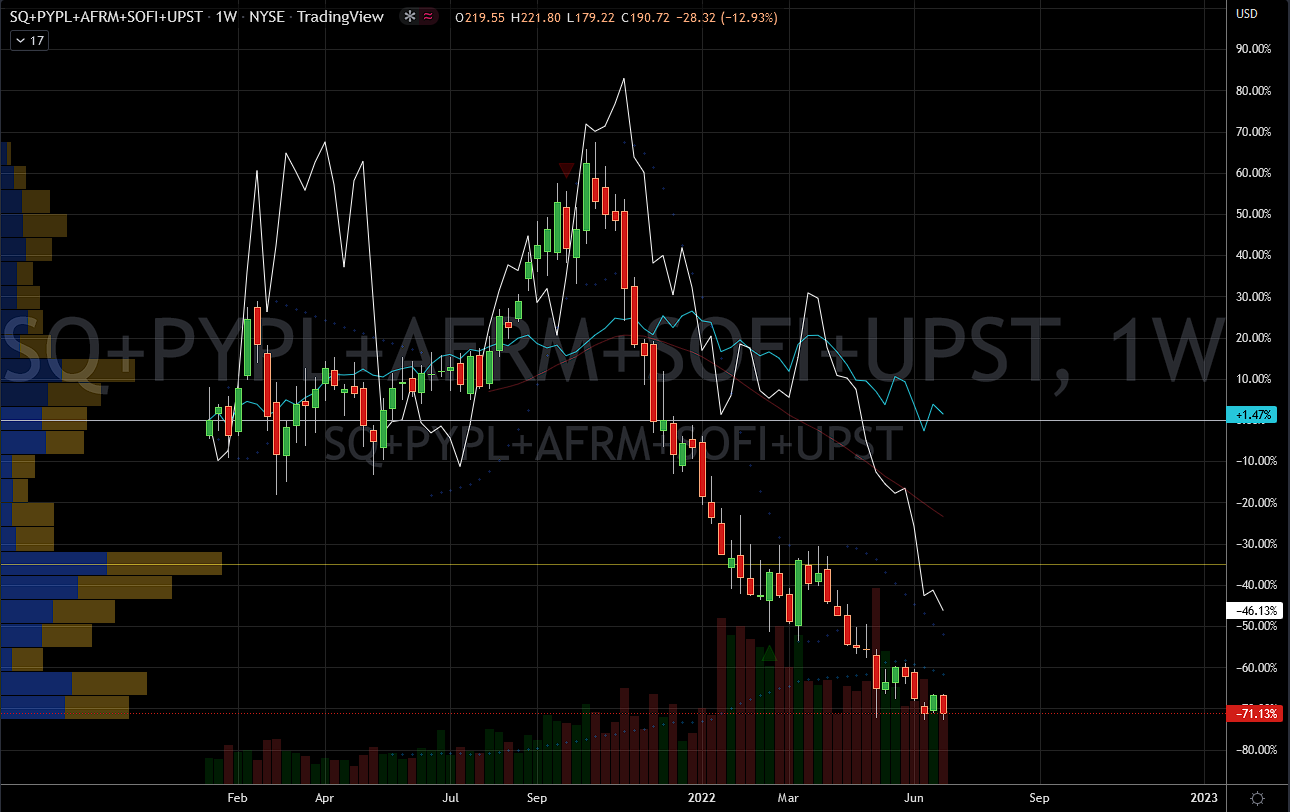7 best Fintech shares to buy in July
The task today is to find seven best fintech shares to buy in July. The sector has already suffered enormous devastation on Wall Street. This month it may be time to start a change. It will probably not happen overnight, but the pendulum may be close to reverse. In some of the discussions, we will also address what is happening Bitcoin (BTC-USD) and the cryptosphere.
These major stocks have been falling steadily for more than almost a year. What made them so attractive to investors last year has become toxic now. The general market instability is a contributor, but their pain started a little earlier and is harder. Even these best of the best fintech stocks have lost 80% of their value. The puzzle is that their fundamentals are still close to record levels.
Innovation in financial technology has been the reason for owning the best fintech shares. The leaders have taken part in the blockchain theme that supports the crypto revolution. But since Bitcoin crashed 70% from its heights, new fintech stocks lost a major catalyst. The connection to crypto and blockchain became deadweight.

Source: Charts by TradingView
To prove the point, I present a crypto chart with three of the seven best fintech stocks discussed today. You can see how they trade with BTC (white line) and do not track SPY (blue). Therefore, it is important for BTC-USD to find support soon. Fortunately, this has been my goal since November, so it can happen. However, there is now a secondary target lower that can extend the loss just as much longer.
Finally, Bitcoin could break below $ 10,000. Therefore, the stocks we are discussing today may have some external fat to remove from the sympathy band of crypto. Otherwise, on their own, they have no weaknesses that guarantee the sales they have received. It is also the wrinkle that is the war that the US Federal Reserve is waging against equities.
They must ease the rhetoric before they destroy the economy, otherwise all stocks can continue to correct. It is a reasonable scenario that will place NASDAQ 25% lower by August. We can still avoid it, but we must admit that the threat is there. But to be sure, I would not take anyone all in positions until we learn more.
| SQ | Block | $ 65.23 |
| PYPL | PayPal | $ 5.91 |
| V | Visa | $ 199.76 |
| MA | MasterCard | $ 319.22 |
| AXP | America Express | $ 138.84 |
| SOFI | SoFi | $ 5.91 |
| AFRM | Confirm | $ 20.1 |
Block (SQ)

Source: Sergei Elagin / Shutterstock.com
Block (SNEEZE:SQ) broke onto the scene in 2009, and it has not stopped creating anything new. The company’s financial results speak well of their efforts. According to Yahoo Finance, management has increased its revenues fivefold in less than five years. More importantly, they do this without building bloating. Although their net income shows a loss, they generate almost a billion in cash from operations.
It is a sign of strength and team spirit. Aggressive companies spend pretty much everything they earn on growing. This is not a waste when the results give a will. Unfortunately, the investment community has been avoiding SQ stocks for some time. Finally, when risk appetite returns, they will seek quality in all sectors. Among them, SQ will stand out as the best fintech stock to buy, perhaps as early as now.
The technical shows resistance, but if the bulls manage $ 66 per share, they can trigger a bullish scenario. Momentum buyers can start the wave, then value investors will follow later. The quality usually rises, and all the SQ stock needs is a little upside pressure from the indices. Watch out for Bitcoin prices because they affect what happens to SQ. Allow for mistakes only from that perspective as well.
PayPal (PYPL)

Everything we have already said about SQ applies PayPal (NASDAQ:PYPL) storage. They are similar in many ways, as they both stood up to challenge the established, older credit card companies.
PayPal appeared about a decade before Block, and they have grown since. They have also made good strategic acquisitions. Even Venmo is now one of their subsidiaries, and it is starting to become a verb in ordinary conversation.
The economics of PYPL stocks are as impressive as SQs. They did not increase their income fivefold, but it is more difficult to do so in size. PYPL sales are already 1.5 times larger and they are more mature. The growth spurt is steeper in earlier stages of the company. The bottom line is that the PayPal foundation is solid, but investors hate it. Unless there is a secret skeleton in the end, when the markets stabilize, buyers will come back to it.
In the short term, there are resistance lines between $ 72 to $ 74 per share. So far, the support has not lasted long, but it still has some at $ 69 and $ 67.7. If I could just pick one of these two best fintech companies, it would be SQ.
Visa (V)

Source: Kikinunchi / Shutterstock.com
The first ‘BankAmericard’ Visa (SNEEZE:V) the card is older than me and I’m no spring chicken. So it definitely belongs on the list of best fintech stocks to buy.
At the moment, the V-share is in the middle of an area that has been stable for over a year. By comparison, this stability is refreshing, considering the overall volatility of stocks. But if the goal is to make money on gratitude, we should dig a little.
Since last summer, investors have defended the V-share, which goes in at $ 190 per share. I expect them to do it again. But in case they do not, investors should only distribute partial positions now. This means that if it is already long, it will be a potential mistake to add risk. If the V stock falls below $ 170, it will be a place to take yourself more seriously or increase the risk.
It is not necessary to delve into their financial health, because they are fortresses. They operate under heavy regulations, especially after the financial crisis in 2008. There is very little wrong except that they are slow-moving snails that compare them to say Block or PayPal.
MasterCard (MA)

Source: Alexander Yakimov / Shutterstock.com
MasterCard (SNEEZE:MA) stock economy is not as big as Visas. But they also doubled their income and net income in seven years. It is clear that the management is firing on all cylinders and there is no blow to them internally. So the stocks suffer more from market sentiment fluctuations than operational success.
At present, the Fed’s efforts to kill spending will affect the earnings power of these transactors. So from that perspective, there is a potential fainting on the horizon. There is reasonable doubt that the Fed will fail to slow down the economy too much. I bet they’m bluffing about how high they want to take interest rates. Too high and they will cause insolvency problems. It would be a national balance problem that the White House wants to avoid.
As long as the bulls keep MA stock above $ 300, they will remain in control. They have a strong base that extends $ 20 lower in case they need it. In any case, falls would provide good buying opportunities. The MA share is even now below the 2020 heights before the pandemic. Therefore, there is not much “free money” foam in it.
American Express (AXP)

Source: Shutterstock
Of the three famous old dogs, America Express (SNEEZE:AXP) is the oldest. They issued their first multinational card in 1958. Age has its privileges. I refer to their slogan “membership has its privileges,” so it is still one of the best fintech stocks. AXP revenues are 1.8 times larger than Visa’s, so investors should respect that.
Oddly enough, their net income loses to the V share. This puts a dent in them in my book. So it would not be the one I choose from the three old fintech companies. But, judging by the AXP stock, investors may not share my concerns. This is if you judge it by the levels before the pandemic. But the technical analyst eye in me sees that the bulls lost an important line.
AXP $ 150 per share was important to keep, but they failed. So now there is a risk of forward resistance. It’s not always the kiss of death, but it’s important that they recover and hold fast. For safety’s sake, I would rather postpone the entrance here for a couple of days at least.
SoFi (SOFI)

Source: Michael Vi / Shutterstock
While I like the business SoFi (NASDAQ:SOFI), I dislike its position with Wall Street. Investors do not care so much money is bearish on SOFI stocks. It shows enormous potential on some days, only to crash and make new downturns shortly afterwards. But this will eventually change if management continues to implement the plans as well.
According to Yahoo Finance SoFi more than quadrupled its revenue in four years. There is hardly any reason to sell the stock down as if it goes out of business. The difficult point is probably that they use a lot to make it happen. So the concern is that rising prices could reduce management’s availability of cash. I am willing to give them the benefit of the doubt and still seek a bottom.
Of course I classify this as a speculative effort in an already controversial industry it seems. It will rank at the low end of my best fintech stocks to buy. Resistance levels are close to $ 5.75 and $ 6. This is where dark pool money becomes active (tradytics.com subscription source). I imagine that it may be nonsense for the bulls to trust them.
Confirm (AFRM)

Source: Piotr Swat / Shutterstock.com
Almost all the arguments I made for SoFi apply Confirm (NASDAQ:AFRM) storage. This is also a relatively new player, but one that is doing well operationally. I come across their digital marketing everywhere and even in my inbox.
In fact, Affirm’s financial statistics are even better than SoFi. According to Yahoo Finance they have increased revenues almost five times since 2018. It is difficult to argue with these results even though the management also spends a lot on it. Finally, they will reap the rewards of risking money now. Just ask Amazon (NASDAQ:AMZN) or Tesla (NASDAQ:TSLA).
Just like SOFI, the AFRM share is out of favor among investors and for a while. There is nothing but visible resistance above and no functional support. However, the last two bounce levels from June and May are actually supportive. The stock jumped off them strongly so that buyers have the opportunity to repeat. If they fail, each line will be one accelerator lower. I do not think it will happen unless it does S&P 500 also corrects.
On the date of publication, Nicolas Chahine did not have (either directly or indirectly) any positions in the securities mentioned in this article. The opinions expressed in this article are those of the author, subject to the InvestorPlace.com Publishing Guidelines.


